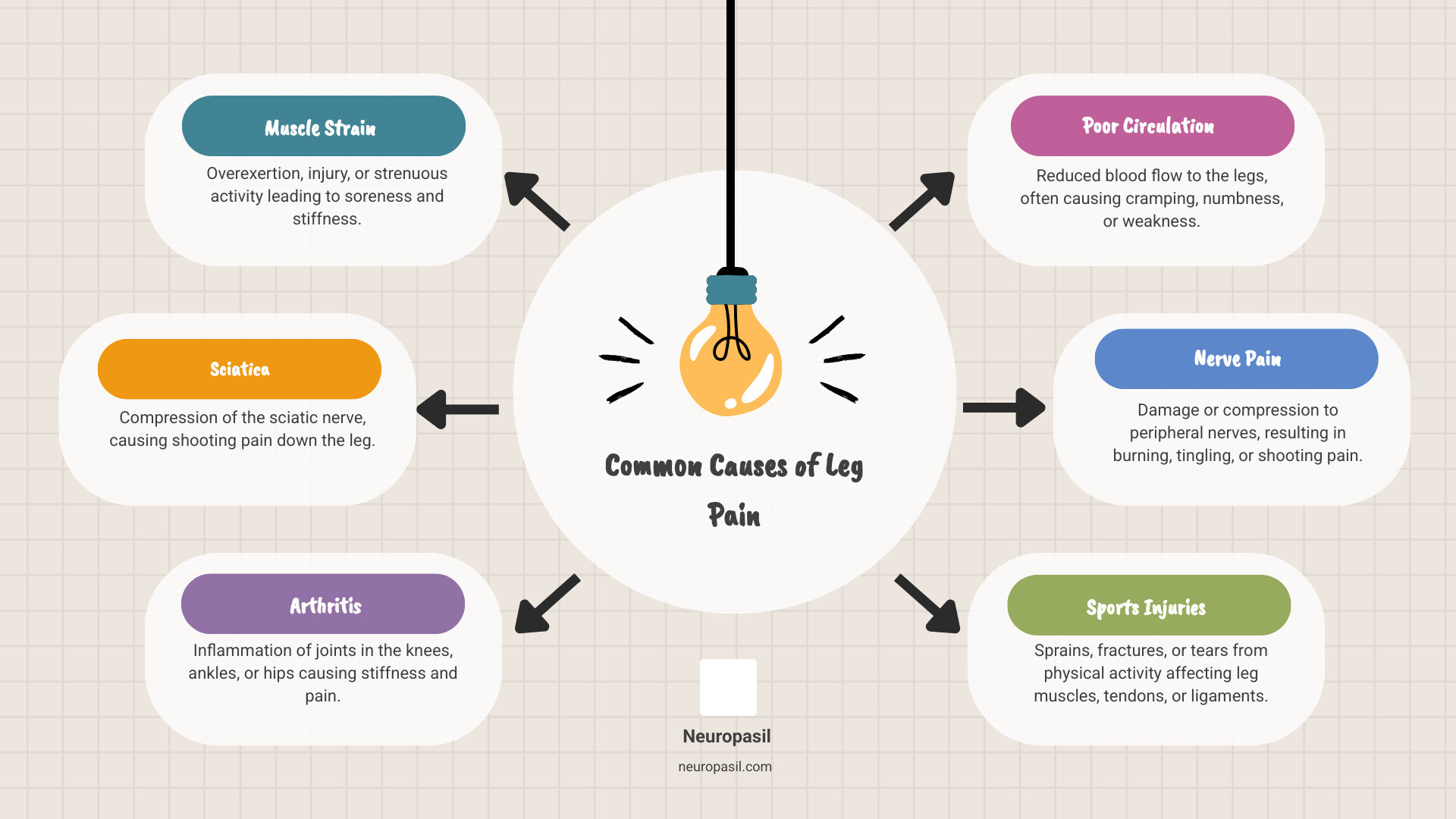Why Your Legs Ache and How Creams Can Help
Leg pain relief cream offers targeted treatment for muscle aches, joint discomfort, and nerve pain without the systemic side effects of oral medications. Unlike pills that affect your whole body, creams deliver active ingredients directly to the source of your discomfort for faster, more localized relief.
The key is matching the right active ingredient to your specific pain. For example:
- Anti-inflammatories like diclofenac reduce swelling.
- Counterirritants like menthol create a cooling sensation to distract from pain.
- Anesthetics like lidocaine temporarily numb the area.
- Natural ingredients like arnica can help with soreness and tissue healing.
These topicals work by interfering with the neural pathways that send pain signals to your brain, minimizing the perception of soreness while your body heals.

Understanding the Source of Your Pain
To choose the most effective cream, it helps to identify the cause of your pain.
Muscle soreness is a common result of intense workouts or new physical activity. The muscles feel stiff and tender as they repair. For more on managing this, see our post: Neuropasil for Muscle Pain.
Nerve pain often feels like a burning, tingling, or shooting sensation. A classic example is sciatica, where the sciatic nerve is compressed, causing pain to radiate down the leg. If you're dealing with sciatica, you may find our guide helpful: Neuropasil for Sciatica Pain.
Arthritis involves joint inflammation, leading to stiffness, swelling, and chronic pain in the knees and ankles. This persistent ache can severely impact mobility. For support, read our guide: Neuropasil for Arthritis Pain.
Other causes include poor circulation, injuries like strains and sprains, tendonitis, or conditions like plantar fasciitis and heel pain.
How Topical Creams Work
Leg pain relief creams work locally to interrupt pain signals before they reach the brain.
Many creams use counterirritants like menthol and camphor. They create a cooling or warming sensation that distracts your brain from the underlying pain, a concept explained by the gate control theory of pain.
Anesthetics, such as lidocaine, temporarily numb the nerves in the applied area, blocking pain signals from being sent. This is especially useful for sharp, localized nerve pain. For more on this topic, see our insights: Neuropasil for Nerve Pain Relief.
Some creams contain NSAIDs (Non-Steroidal Anti-Inflammatory Drugs) like diclofenac. These actively reduce inflammationa common root cause of painby inhibiting the production of prostaglandins, the chemicals that cause swelling and pain.
The localized effect of creams means fewer systemic side effects compared to oral medications, making them a preferred choice for many.
Decoding the Label: Key Ingredients in Pain Relief Creams
When you're standing in the pharmacy aisle, understanding the ingredients in a leg pain relief cream helps you choose the right product. Creams contain active ingredients for pain-fighting, often supplemented by natural ingredients with anti-inflammatory properties. Each type works differently, so knowing what to look for is key.

Counterirritants for a Cooling Sensation
Counterirritants create a cooling or tingling sensation to distract your brain from pain. This is based on the gate control theory of pain, where non-painful sensations can block pain signals from reaching the brain.
Menthol, derived from peppermint, is a popular counterirritant that delivers an instant cooling effect on sore muscles.
Camphor and methyl salicylate (from wintergreen oil) often create a warming sensation. Many products combine these ingredients for a hot-and-cold effect. These are ideal for quick relief from everyday muscle soreness and stiffness.
Anesthetics for Numbing Relief
For sharp or stabbing pain, anesthetics offer direct numbing. Lidocaine is the most common ingredient in this category.
Lidocaine works by temporarily blocking nerve pathways that carry pain signals, creating numbness in the treated area. This makes it highly effective for nerve-related pain, as it directly interrupts the electrical signals nerves use to communicate pain. For more on tackling nerve pain, check out our guide on Neuropasil for Nerve Pain Relief.
NSAIDs for Anti-Inflammatory Action
Unlike ingredients that just manage symptoms, NSAIDs (Non-Steroidal Anti-Inflammatory Drugs) target a root cause of pain: inflammation.
Diclofenac is a common topical NSAID that works by blocking the production of prostaglandins—the chemicals that cause swelling, heat, and pain. By reducing inflammation at the source, it provides effective relief. This makes topical NSAIDs an excellent choice for pain related to injury or arthritis.
Natural and Homeopathic Ingredients
Many people prefer natural options, which often have centuries of traditional use and modern research to back them up.
- Arnica: A flowering plant known for its ability to reduce bruising and swelling, making it a go-to for muscle soreness.
- Capsaicin: Extracted from chili peppers, it creates a warmth sensation. With regular use, it can deplete Substance P, a neurotransmitter that transmits pain signals.
- Turmeric and Boswellia Serrata: These are powerful natural anti-inflammatories. Turmeric's active compound, curcumin, is a potent antioxidant, while Boswellia (frankincense) has long been used for joint pain.
These natural ingredients are often gentler on the skin and offer a holistic approach to pain management. For tendon-related issues, our Neuropasil for Tendonitis guide may be helpful.
Choosing the Right Leg Pain Relief Cream for You
With so many options available, finding the right leg pain relief cream can be overwhelming. Instead of focusing on brands, the best approach is to match the active ingredients to the type of pain you're experiencing. Here’s a guide to help you choose.
For Arthritis and Joint Inflammation
If your leg pain is caused by arthritis or an injury involving swelling, you need an anti-inflammatory.
- What to look for: Creams containing a topical NSAID like diclofenac. This ingredient is clinically proven to reduce inflammation at the source, providing relief from the stiffness and aching of joint pain.
- How it works: It inhibits the production of prostaglandins, the chemicals responsible for inflammation and pain. This makes it more than just a pain masker; it actively treats the swelling.
For Post-Workout Soreness and Muscle Strain
For general muscle aches and the soreness that follows a tough workout, a cooling cream can provide fast, satisfying relief.
- What to look for: Products with a high concentration of menthol. This counterirritant creates an intense cooling sensation that distracts your brain from the pain.
- Application tip: Look for convenient applicators like roll-ons, which allow for a mess-free application, perfect for use at the gym or on the go. This type of fast-acting relief is ideal for athletes. For more on athletic recovery, see our guide: Neuropasil for Athletes.
For Nerve Pain and Targeted Numbing
When pain is sharp, shooting, or burning—often a sign of nerve involvement like sciatica—a numbing agent is your best bet.
- What to look for: A cream with lidocaine as the primary active ingredient. Some formulas may also include a small amount of menthol for a complementary cooling effect.
- How it works: Lidocaine is a local anesthetic that blocks nerve signals in the affected area, preventing them from reaching your brain. This provides temporary but effective numbness. Look for fragrance-free options if you are sensitive to strong smells.
For a Gentle, Natural Approach
If you prefer to use plant-based ingredients or have sensitive skin, a natural pain relief cream is an excellent choice.
- What to look for: A blend of ingredients like Arnica (for bruising and soreness), MSM (to support connective tissue), Vitamin B6 (for nerve health), and anti-inflammatory herbs like Boswellia Serrata.
- Benefits: These creams are often non-greasy, have vanishing scents, and are generally safe to use alongside other therapies like ice packs or physical therapy. They offer a holistic way to manage daily aches and pains.
Maximizing Relief and Ensuring Safety
To get the most out of your leg pain relief cream, it's important to use it correctly and safely. How you apply the cream can be just as important as which one you choose.

Proper Application for Best Results
- Start with clean, dry skin to ensure maximum absorption.
- Massage thoroughly for 1-2 minutes until the cream is fully absorbed. This also helps stimulate blood flow.
- Follow label directions regarding frequency. More is not always better and can lead to skin irritation. Some creams are for use 3-4 times daily, while others are for every 12 hours.
- Wash hands after use to avoid accidentally getting cream in your eyes or other sensitive areas.
- Patch test first by applying a small amount to your inner arm and waiting to check for any adverse reaction.
- Never apply to broken skin, cuts, or open wounds.
Potential Side Effects and Precautions
While generally safe, topical creams can have side effects. Skin irritation, such as redness, itching, or a burning sensation, is the most common. If irritation is severe, stop using the product. Allergic reactions are also possible, which is why a patch test is crucial.
For your safety:
- Do not use with heating pads. Combining heat with pain creams can increase absorption and cause serious skin burns.
- Avoid contact with eyes, mouth, and other mucous membranes.
- Store properly at room temperature and out of reach of children and pets.
Combining Creams with Other Therapies
A pain relief cream is most effective as part of a broader treatment plan.
- R.I.C.E. Method: Creams work well with Rest, Ice, Compression, and Elevation. Ice packs can be used with cooling creams, but avoid heat.
- Physical Therapy: Applying cream before stretching or therapeutic exercises can make your sessions more comfortable and effective.
- Post-Workout Recovery: Creams help manage discomfort after a workout, making the recovery period more tolerable. Learn more in our guide: Neuropasil for Muscle Soreness After Workout.
These complementary treatments can work synergistically with your cream for better overall results.
When to Consult a Doctor for Leg Pain
While leg pain relief cream is great for minor issues, some symptoms are red flags that require professional medical attention. Creams can manage discomfort, but they can't fix serious underlying problems.

Signs Your Leg Pain Is Serious
Seek immediate medical advice if you experience any of the following:
- Severe, sudden pain, especially after an injury.
- Inability to walk or bear weight on the affected leg.
- Signs of infection, such as fever, increasing redness, warmth, or drainage.
- Significant swelling with no clear cause, particularly if it's in only one leg, as this could indicate a blood clot.
- An injury involving a deep cut or exposed bone.
- Calf pain after long periods of sitting (like a long flight), which could be a sign of deep vein thrombosis (DVT).
- New or worsening numbness, tingling, or weakness in the leg or foot.
- Pain that worsens or doesn't improve after several days of home treatment.
Trust your instincts. If your pain feels serious or significantly impacts your daily life, it's time to see a doctor for an accurate diagnosis and a comprehensive treatment plan.
Find Your Stride with the Right Relief
We've explored leg pain relief cream, from the science behind the ingredients to choosing the right product for your needs. The key takeaway is the importance of ingredients. Knowing whether you need the cooling power of menthol, the numbing effect of lidocaine, the anti-inflammatory action of diclofenac, or the gentle support of natural ingredients like arnica puts you in control of your pain relief.
Your pain is unique, and your solution should be too. User preference matters—whether you prefer a roll-on applicator, a fragrance-free formula, or a non-greasy cream, the right product is one you'll use consistently.
Remember to follow proper application techniques, including patch testing and massaging the cream in thoroughly, to get the best results safely. A pain relief cream works best as part of a team, complementing other therapies like rest, ice, and physical therapy.
It's also crucial to know when a cream isn't enough. Severe, sudden, or persistent pain, especially with symptoms like swelling or fever, requires a doctor's attention. Your legs carry you through life, and they deserve professional care when something is seriously wrong.
For those dealing with the specific challenges of nerve pain, such as sciatica, a specialized approach can make all the difference. This type of pain requires a thoughtful, targeted strategy. Neuropasil offers solutions designed for nerve-related discomfort. If sciatica is making every step a challenge, you don't have to suffer in silence. Learn how to manage sciatica pain and find approaches that can help you reclaim your comfort and mobility.
With this knowledge, you can make smart choices, find what works for you, and keep moving forward. Here's to finding your stride and keeping it strong!














